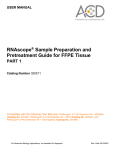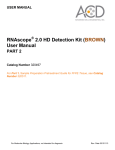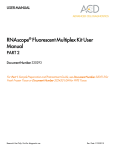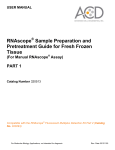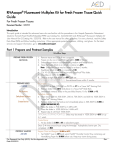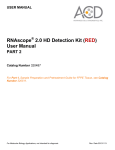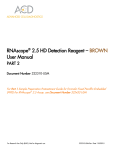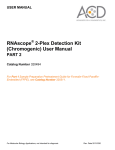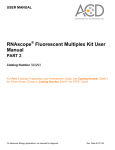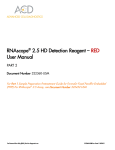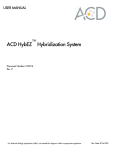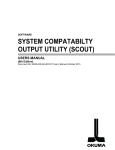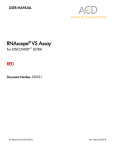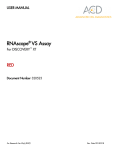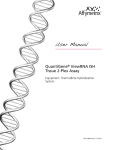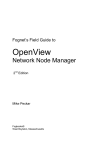Download 320513_FreshFrozen SamplePrep Part1_UM_11052015
Transcript
USER MANUAL RNAscope® Sample Preparation and Pretreatment Guide for Fresh Frozen Tissue using RNAscope® Fluorescent Multiplex Assay PART 1 Document Number 320513 Compatible with the RNAscope® Fluorescent Multiplex Detection Kit User Manual Part 2, see Document Number 320293. For Research Use Only (RUO). Not for Diagnostic Use Rev. Date 11052015 For Research Use Only (RUO). Not for D iagnostic Use Tr ademarks RNAscope® and HybEZ™ are trademarks of Advanced Cell Diagnostics, Inc. All other trademarks belong to their respective owners. ® Citing RNAscope in Publications When describing a procedure for publication using this product, please refer to it as the RNAscope ® 2.0 Assay and cite: Wang F, Flanagan J, Su N, Wang L-C, Bui S, Nielson A, Wu X, Vo H-T, Ma X-J and Luo Y. RNAscope: A Novel In Situ RNA Analysis Platform for Formalin-Fixed Paraffin-Embedded Tissues. J. Mol. Diagnostics, 2012, 14:22-29. D isclaimer s Advanced Cell Diagnostics, Inc. reserves the right to change its products and services at any time to incorporate technological developments. This manual is subject to change without notice. Although this manual has been prepared with every precaution to ensure accuracy, Advanced Cell Diagnostics, Inc. assumes no liability for any errors, omissions, or for any damages resulting from the use of this information. C opyright © 2015. Advanced Cell Diagnostics, Inc. All rights reserved. Contents Chapter 1. Product Information ..................................................5 About this guide.........................................................................................5 Product description .....................................................................................5 Background .......................................................................................... 5 Sample types......................................................................................... 5 RNAscope ® Assay reagents .................................................................... 6 RNAscope ® Reagent Kit .......................................................................... 6 Requir ed materials and equ ipment ...............................................................7 HybEZ™ Hybridization System ................................................................. 7 User-supplied materials .......................................................................... 7 Chapter 2. Before You Begin .....................................................9 Important procedural guidelines ...................................................................9 Chapter 3. Prepare and Pretreat Samples ....................................10 Prepare fresh frozen sections .....................................................................10 Materials required ............................................................................... 10 Prepare the block................................................................................. 10 Section the block.................................................................................. 10 Prepare the slides for the RNAscope® Assay ................................................11 Workflow ........................................................................................... 11 Materials required ............................................................................... 12 Fix the sections .................................................................................... 12 Dehydrate the sections.......................................................................... 12 Create a hydrophobic barrier ................................................................ 12 Pretreat samples.......................................................................................13 Materials required ............................................................................... 13 Prepare the equipment ......................................................................... 13 Apply Protease IV ................................................................................ 13 Proceed to the RNAscope® Assay ...............................................................14 15BTroubleshooting..................................................................................14 Appendix A. Reagent Volume Guidelines ....................................15 Determine reagent volume .........................................................................15 Appendix B.Safety ................................................................16 Chemical safety........................................................................................16 Biological hazard safety............................................................................16 Sample Preparation and Pr etreatment Guide for Fresh Frozen Tissue 3 Documentation and Support ....................................................18 Obtaining MSDSs ....................................................................................18 Obtaining su pport ....................................................................................18 Contact information ..................................................................................18 Limited product warranty...........................................................................18 4 Sample Preparation and Pretreatment Guide for Fresh Frozen Tissue Chapter 1. Product Information 1 Before using this product, read and understand the information in Appendix B. Safety on page 16 in this document. IMPORTANT! We recommend reading the entire user manual before beginning any protocols. About this guide This user guide provides guidelines and protocols for the proper preparation and pretreatment of fresh, frozen tissues mounted on slides. The slides can then be assayed using an RNAscope ® Reagent Kit. RNAscope® Reagent Kits come with a separate RNAscope® Assay User Manual. Do not perform an RNAscope® Assay without the correct user manual. Product description Background The RNAscope® Assays use a novel and proprietary method of in situ hybridization (ISH) to visualize single RNA molecules per cell in samples mounted on slides. The assays are based on ACD’s patented signal amplification and background suppression technology. Proprietary RNAspecific probes are hybridized to target RNA, and are then bound to a cascade of signal amplification molecules culminating in signal detection (Figure 1). Single-plex, 2-plex, multiplex, and automated assays are all available. The RNAscope ® Assay procedure is illustrated in Figure 1 on page 6 and can be completed in 6–10 hours depending on the assay, or conveniently divided over two days. Most RNAscope ® Assay reagents are available in convenient Ready-ToUse (RTU) dropper bottles and provide a simple, nearly pipette-free workflow. Results are observable using standard bright field or fluorescent microscopy. Sample types In order to perform the RNAscope® Assays, you must start with properly prepared and pretreated samples. Multiple sample types are now compatible with RNAscope ® Assays and include: formalin-fixed, paraffin-embedded (FFPE) tissues, fresh, frozen tissues, fixed, frozen tissues, tissue microarray (TMA), and cell samples. Visit www.acdbio.com and contact [email protected] for more information. Sample Preparation and Pr etreatment Guide for Fresh Frozen Tissue 5 Figure 1 Procedure overview 1: Tissue section 2:Hybridize to target RNA Start with properly prepared tissue sections and pretreat to allow access to target RNA. Hybridize multiple sets of gene-specific probe pairs to target mRNAs. 3: Am plify signal 4: Im age Use up to four signal amplification systems to detect multiple target RNAs. Probes are hybridized to a cascade of signal amplification molecules, culminating in binding of dye-labeled probes visible in different fluorescent channels. Visualize target RNA using a standard fluorescent microscope. RNAscope® Assay reagents RNAscope® Assays require the RNAscope® Probes and an RNAscope® Reagent Kit. If you are performing an automated assay using the Ventana® DISCOVERY XT or ULTRA Systems, you must use RNAscope® VS Probes and the RNAscope® VS Reagent Kit. Probes and Reagent Kits are available separately. Visit www.acdbio.com/products/target-probes/search-product to find a gene-specific Target Probe. Visit http://www.acdbio.com/control-slides-and-probes to order appropriate Control Probes. RNAscope® Reagent Kit Each RNAscope® Reagent Kit provides enough reagents to stain ~20 tissue sections approximately 20 mm x 20 mm large. Larger tissue sections will result in fewer tests. Each kit contains three sub-kits including a Pretreatment Kit, which come with up to three reagents. Pretreatment of Fresh Frozen tissue (Cat. No. 322340) requires only Protease IV. Pretreatment Kit instructions are provided in this guide. For information on the other sub-kits and directions for use, refer to an RNAscope® Assay User Manual. The reagents have a shelf life of nine months from the date of bulk manufacture when stored as indicated in the following table: Pretrea tment Kit ( Ca t. No. 320842) R ea g ent Qua ntity Protease III—1X Ready-To-Use (RTU) protease 4.5 mL x 1 bottle Protease IV—2X Ready-To-Use (RTU) protease 4.5 mL x 2 bottle Stora g e 4°C Note: Use Protease III with Cultured Adherent Cells and Peripheral Blood Mononuclear Cells (PBMC). Use Protease IV for Fresh Frozen Tissues. IMPORTANT! RNAscope® Reagent Kits share the same Pretreatment Kit and Wash Buffer, but have unique Detection Kits. Do not interchange the reagent components of the Detection Kits, even those having the same name. 6 Sample Preparation and Pretreatment Guide for Fresh Frozen Tissue Required materials and equipment The following materials and equipment are needed to perform the RNAscope ® Assay. HybEZ™ Hybridization System IMPORTANT! The RNAscope® Assay has been validated using this system only. The HybEZ™ Hybridization System (110 VAC, Cat. no. 310010; 220 VAC, Cat. no. 310013) is designed for the hybridization and incubation steps in the RNAscope® Assays. Incubation steps in the RNAscope® Assay require humid conditions to prevent sections from drying out. For instructions on how to use the HybEZ™ Hybridization System, refer to the HybEZ™ Hybridization System User Manual available at www.acdbio.com/technical-support/user-manuals and view the training video at www.acdbio.com/technical-support/learn-more. The system contains the following components: Comp onent Qua ntity Ca t. No. HybEZ Oven (110 or 220 VAC) 1 oven 310010 or 310013 HybEZ ™ Humidity Control Tray (with lid) 1 tray 310012 HybEZ Slide Rack (20 slide capacity) 1 rack 310014 HybEZ ™ Humidifying Paper 2 sheets — HybEZ Humidifying Paper Pack 15 sheets 310015 ™ ™ ™ User-supplied materials IMPORTANT! Do not substitute other materials for the ImmEdge™ Hydrophobic Barrier Pen and the SuperFrost® Plus Slides listed in the following table. Des crip tion Sup p l ier Ca t. No. ImmEdge Hydrophobic Barrier Pen (required) Vector Laboratory H-4000 SuperFrost® Plus Slides (required) Fisher Scientific 12-550-15 100% ethanol American Master Tech Scientific/MLS* ALREAGAL Tissue-Tek ® Vertical 24 Slide Rack American Master Tech Scientific/MLS LWSRA24 Tissue-Tek ® Staining Dish (6 required) American Master Tech Scientific/MLS LWT4457EA Tissue-Tek ® Clearing Agent Dish, xylene resistant (3 required) American Master Tech Scientific/MLS ProLong® Gold Antifade Reagent Life Technologies P36930 Cover glass 24 x 50 mm Fisher Scientific/MLS 12--545-F Ammonium hydroxide, 28–30% Sigma-Aldrich/MLS 320145-500mL Carboy (>3L) MLS — Water bath or incubator, capable of holding temperature at 40 +/- 1°C MLS — Pipettors and tips, 1–1000 µL MLS — ™ Sample Preparation and Pr etreatment Guide for Fresh Frozen Tissue LWT4456EA 7 Des crip tion Sup p l ier Ca t. No. Distilled water MLS — Tubes (various sizes) MLS — Fume hood MLS — Graduated cylinder MLS — Parafilm MLS — Paper towel or absorbent paper MLS — Glass beaker (1 or 2 L) MLS — Hot plate Fisher Scientific/MLS 11-300-49SHP Aluminum foil MLS — Forceps, large MLS — Thermometer MLS — 20% bleach MLS — Microscope and accessories MLS — * Major Laboratory Supplier in North America. For other regions, please check Catalog Numbers with your local lab supplier. 8 Sample Preparation and Pretreatment Guide for Fresh Frozen Tissue 2 Chapter 2. Before You Begin Prior to running the RNAscope® Assay on your samples for the first time, we recommend that you: • View the video demonstrations available at http://www.acdbio.com/technical-support/learn-more. Important procedural guidelines • Start with properly fixed and prepared sections. • Always run positive and negative control probes on your sample to assess sample RNA quality and optimal permeabilization. • Do not substitute required materials. Assay has been validated with these materials only. • Follow the protocol exactly for best results. • Use good laboratory practices and follow all necessary safety procedures. Refer to Appendix B. Safety on page 16 for more information. Sample Preparation and Pr etreatment Guide for Fresh Frozen Tissue 9 Chapter 3. Prepare and Pretreat Samples 3 Fresh, frozen sample preparation and pretreatment are described in the following protocol. For other sample types and preparation methods, contact [email protected] for the latest protocols and guidelines. IMPORTANT! We highly recommend following these guidelines. We cannot guarantee assay results with other preparation methods. Prepare fresh frozen sections Materials required • Scalpel • Forceps • Cryo-embedding medium (OCT) • Dry ice, liquid nitrogen, or isopentane • Cryostat • Slide boxes • SuperFrost® Plus slides • Aluminum foil or zip-lock bags Prepare the block 1. Remove tissue and cut to fit into cryomolds. CAUTION! Handle biological specimens appropriately. 2. Freeze the specimen on dry ice or in liquid Nitrogen within 5 MIN of tissue harvest. 3. Embed frozen tissue in cryo-embedding medium (OCT): a. Add two drops of OCT into a cryomold. b. Place the frozen tissue on the OCT in the correct orientation for cutting. c. Add more OCT to fill the cryomold. Do not allow any air bubbles to form. d. Hold the block with forceps on the surface of liquid nitrogen or isopentane cooled by dry ice or liquid nitrogen, or place the cryomold on dry ice. 4. Store the frozen block in an air-tight container at –80°C prior to sectioning. Note: Embedded tissue may be stored for at least 3 MONTHS. Section the block 1. Equilibrate block to –20°C in a cryostat ~1 HR. 2. Cut 10–20 µm sections and mount onto SUPERFROST® PLUS SLIDES. 10 Sample Preparation and Pretreatment Guide for Fresh Frozen Tissue 3. Keep the sections at –20°C to dry. 4. Store the sections in slide boxes wrapped air-tight with aluminum foil or zip-lock bags at –80°C until use. Note: Sections may be stored for at least 3 MONTHS. IMPORTANT! Do not fix the slides prior to this step. OPTIONAL STOPPING POINT (1). Use sectioned tissue within 3 months. Prepare the slides for the RNAscope® Assay Workflow F ix the s ections ~15 MI N Dehyd ra te the s ections ~20 MI N (Optional ) Stopping Point (2) Crea te a hyd rop hob ic b a rrier ~10 MI N Ap p l y Protea s e I V ~30 MI N Proceed I MMEDI ATEL Y to the R NAs cop e ® As s a y* * Immediately proceed to the RNAscope® Fluorescent Multiplex Detection Kit Part 2 User Manual, Document No. 320293. Sample Preparation and Pr etreatment Guide for Fresh Frozen Tissue 11 Materials required • 1X PBS • 10% neutral buffered formalin (NBF) • 4% paraformaldehyde • 100% ethanol • Tissue-Tek ® Vertical 24 Slide Rack • Tissue-Tek ® Staining Dishes (5 required) • ImmEdge™ Hydrophobic Barrier Pen Fix the sections 1. Chill 200 mL 10% NBF (fresh 10% NBF or 4% paraformaldehyde in 1X PBS) to 4°C in a Tissue Tek ® Staining Dish. 2. Remove slides from –80°C, and place in a Tissue Tek ® Slide Rack. 3. Immediately immerse slides in the pre-chilled fixative. Fix for 15 MIN at 4°C. Note: Formalin that has been stored for more than six months, exposed to air for more than a week, or used repeatedly may result in suboptimal tissue fixation. Dehydrate the sections Reagents may be prepared ahead of time. Ensure all containers remain covered. 1. Prepare 200 mL 50% ethanol, 200 mL 70% ethanol, and 600 mL 100% ethanol in Tissue Tek ® Staining Dishes. 2. Place the slides in 50% ethanol for 5 MIN at ROOM TEMPERATURE (RT). 3. Place the slides in 70% ethanol for 5 MIN at RT. 4. Place the slides in 100% ethanol for 5 MIN at RT. 5. Repeat step 6 with fresh 100% ethanol. OPTIONAL STOPPING POINT (2). Slides may be stored in 100% ethanol at –20°C for up to 1 WEEK. Prolonged storage may degrade sample RNA. Create a hydrophobic barrier 1. Take slides out of 100% ethanol and place on absorbent paper with the section face-up. Air dry for 5 MIN at RT. 2. Use the following template to draw a barrier 2–4 times around each section with the Immedge™ hydrophobic barrier pen. See example below (size of this hydrophobic barrier is 0.75” x 0.75”). Note: Refer to Appendix A. Reagent Volume Guidelines on page 15 to determine the recommended number of drops needed per slide. IMPORTANT! Do not let the barrier touch the section. The Immedge™ hydrophobic barrier pen is highly recommended. Alternative type of pen may result in suboptimal results. 12 Sample Preparation and Pretreatment Guide for Fresh Frozen Tissue Hyd rophobic Ba rrier: 0 .75” x 0.75” Slide Label Tissue Note: We do not recommend drawing a smaller barrier and using less than the recommended volume amounts, even for smaller sections. Larger barriers will result in fewer tests per kit. 3. Let the barrier dry completely ~1 MIN. Note: If you need to reapply the hydrophobic barrier during the following procedures, dry the appropriate area of the slide with a Kimwipe®. Do not touch the tissue section. Pretreat samples IMPORTANT! Do not apply RNAscope® Hydrogen Peroxide or RNAscope® Target Retrieval to fresh, frozen sections when using the RNAscope® Fluorescent Multiplex Kit. Other sample types may need these treatments. Materials required Ma terials p rovid ed b y the R NAs cop e ® R ea g ent Kit • Protease III & IV Other ma teria l s a nd eq uip ment • Prepared slides • Distilled water • Paper towel or absorbent paper • HybEZ™ Humidifying System • Tissue Tek ® Slide Rack • Tissue Tek ® Staining Dish Prepare the equipment • Turn on HybEZ™ Oven and set temperature to 40°C. • Place a Humidifying Paper in the Humidity Control Tray and wet completely with distilled water. Apply Protease IV IMPORTANT! View the wash step video at www.acdbio.com/technical-support/learn-more before proceeding. 1. Place the dried slides on the HybEZ™ Slide Rack, and add ~5 drops of Protease IV to entirely cover each section. 2. Incubate for 30 MIN at RT. Sample Preparation and Pr etreatment Guide for Fresh Frozen Tissue 13 3. Take each slide one at a time from the HybEZ™ Slide Rack and tap and/or flick to remove the excess liquid. Immediately place each slide in a Tissue-Tek ® Slide Rack submerged in a TissueTek ® Staining Dish filled with 1X PBS. 4. Wash slides with 1X PBS by moving the rack up and down 3–5 times and repeat with 1X PBS. Proceed to the RNAscope ® Assay While slides are incubating, proceed immediately to the RNAscope® Multiplex Fluorescent Detection using the RNAscope® Multiplex Fluorescent Detection Kit User Manual PART 2 (Document No. 320293). Ensure you have the appropriate user manual. User manuals are available at www.acdbio.com/technical-support/user-manuals. For any questions, please contact [email protected]. Note: Slides can stay in 1X PBS for up to 15 MIN. IMPORTANT! Slides should not stay in 1X PBS for longer than 15 MIN. Proceed to RNAscope Fluorescent Multiplex Detection using the RNAscope® Multiplex Fluorescent Detection Kit User Manual PART 2, Document No. 320293. ® T roubleshooting 15B For troubleshooting information, please contact technical support at [email protected]. 14 Sample Preparation and Pretreatment Guide for Fresh Frozen Tissue A Appendix A. Reagent Volume Guidelines Determine reagent volume Before starting your experiment, measure the inner edge of the hydrophobic barrier to determine the recommended number of drops needed per slide (see table below). Size of hyrophobic R ecommend ed R ecommend ed b a rrier* ( in) numb er of d rop s p er s l id e vol ume p er s l id e ( µL ) 0.75” x 0.75” † 4 120 0.75” x 1.0” 5 150 0.75” x 1.25” 6 180 R el a tive temp l a te s ize * Hydrophobic barrier measured at inner edge. References in this user manual are for the 0.75” x 0.75” hydrophobic barrier size. † Recommended hydrophobic barrier size is 0.75” x 0.75”. With this barrier size, each probe is sufficient for staining ~20 sections. Larger tissue sections will result in fewer tests. Sample Preparation and Pr etreatment Guide for Fresh Frozen Tissue 15 Appendix B.Safety B Chemical safety WARNING! GENERAL CHEMICAL HANDLING. To minimize hazards, ensure laboratory personnel read and practice the general safety guidelines for chemical usage, storage, and waste provided below, and consult the relevant SDS for specific precautions and instructions: • Read and understand the Safety Data Sheets (SDSs) provided before you store, handle, or work with any chemicals or hazardous materials. To obtain SDSs, http://www.acdbio.com/technical-support/user-manuals. • Minimize contact with chemicals. Wear appropriate personal protective equipment when handling chemicals (for example, safety glasses, gloves, or protective clothing). • Minimize the inhalation of chemicals. Do not leave chemical containers open. Use only with adequate ventilation (for example, fume hood). • Characterize (by analysis if necessary) the waste generated by the particular applications, reagents, and substrates used in your laboratory. • Ensure that the waste is stored, transferred, transported, and disposed of according to all local, state/provincial, and/or national regulations. • IMPORTANT! Radioactive or biohazardous materials may require special handling, and disposal limitations may apply. Biological hazard safety WARNING! BIOHAZARD. Biological samples such as tissues, body fluids, infectious agents, and blood of humans and other animals have the potential to transmit infectious diseases. Follow all applicable local, state/provincial, and/or national regulations. Wear appropriate protective equipment, which includes but is not limited to: protective eyewear, face shield, clothing/lab coat, and gloves. All work should be conducted in properly equipped facilities using the appropriate safety equipment (for example, physical containment devices). Individuals should be trained according to applicable regulatory and company/institution requirements before working with potentially infectious materials. Read and follow the applicable guidelines and/or regulatory requirements in the following: 16 Sample Preparation and Pretreatment Guide for Fresh Frozen Tissue In the U.S.: • U.S. Department of Health and Human Services guidelines published in Biosafety in Microbiological and Biomedical Laboratories found at: www.cdc.gov/biosafety • Occupational Safety and Health Standards, Bloodborne Pathogens (29 CFR§1910.1030), found at: www.access.gpo.gov/nara/cfr/waisidx_01/%2029cfr1910a_01.html • Your company’s/institution’s Biosafety Program protocols for working with/handling potentially infectious materials. • Additional information about biohazard guidelines is available at: www.cdc.gov/ In the EU: • Check local guidelines and legislation on biohazard and biosafety precaution and refer to the best practices published in the World Health Organization (WHO) Laboratory Biosafety Manual, third edition, found at: www.who.int/csr/resources/publications/biosafety/who_cds_csr_lyo_2004_11/en/ • Information about the Registration, Evaluation, Authorisation and Restriction of Chemicals (REACH) can be found at: eurlex.europa.eu/LexUriServ/LexUriServ.do?uri=OJ:L:2010:133:0001:0043:EN:PDF Sample Preparation and Pr etreatment Guide for Fresh Frozen Tissue 17 Documentation and Support Obtaining MSDSs Safety Data Sheets (SDSs) are available at: www.acdbio.com/technical-support/user-manuals. For the MSDSs of chemicals not distributed by Advanced Cell Diagnostics, contact the chemical manufacturer. Obtaining support For the latest services and support information, go to: www.acdbio.com/technical-support/user- manuals. At the website, you can: • Access telephone and fax numbers to contact Technical Support and Sales facilities. • Search through frequently asked questions (FAQs). • Submit a question directly to Technical Support. • Search for user documents, MSDSs, application notes, citations, training videos, and other product support documents. • Find out information about customer training events. Contact information Advanced Cell Diagnostics, Inc. 3960 Point Eden Way Hayward, CA 94545 Toll Free: 1-877-576-3636 Direct: 1-510-576-8800 Fax: 1-510-576-8801 Information: [email protected] Orders: [email protected] Support Email: [email protected] Limited product warranty Advanced Cell Diagnostics, Inc. and/or its affiliate(s) warrant their products as set forth in the ACD General Terms and Conditions of Sale found on the ADC website at www.acdbio.com/technical-support/user-manuals. If you have any questions, please contact Advanced Cell Diagnostics at www.acdbio.com/about/contact. 18 Sample Preparation and Pretreatment Guide for Fresh Frozen Tissue Headquarters 3960 Point Eden Way Hayward, CA 94545 For support, email [email protected]. www.acdbio.com Phone 1-510-576-8800 Toll Free 1-877-576-3636



















